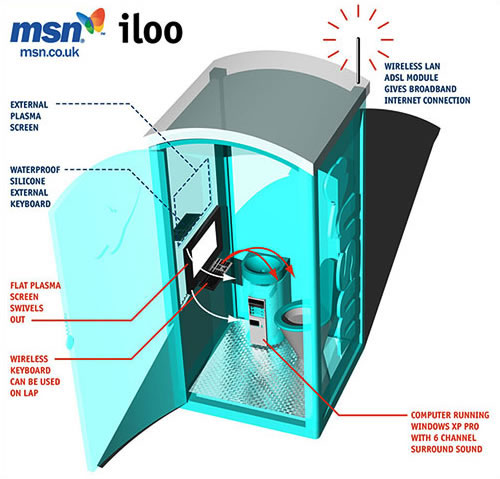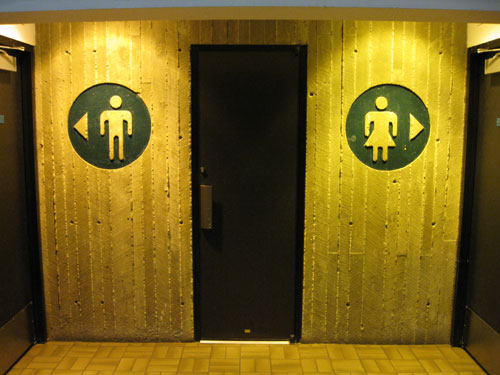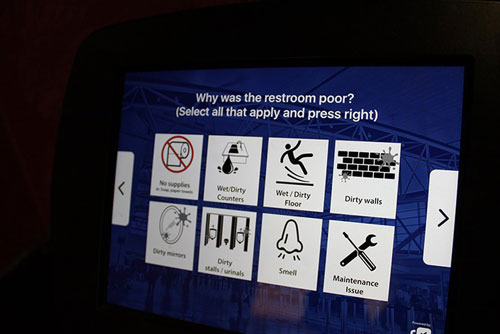The Internet's Final Frontier
Pondering the nature of digital connectivity in the one room nobody wants to consider internet access in, even though we use it all the time: The restroom.
“I’m happy that you’re happy, but the place where you’re supposed to have the toilet paper, you’ve got this little shelf with three seashells on it.”
— John Spartan, a.k.a. Sylvester Stallone, discussing his utter confusion with the way that people use the bathroom in 2032 in the 1993 film Demolition Man. (The character played by Rob Schneider—an actor who was once denied membership in the Academy because his roles didn’t show enough range—mocked Spartan for not knowing how the three seashells work.) The movie, which also famously replaced all restaurants with Taco Bell, never bothers to explain the three-seashell method, making it the world’s greatest unanswered mystery in relation to fictional bathroom technology, even to this day.

Something tells me Apple fans had a field day with this.
How Microsoft invented the world’s first portable smart bathroom, denied it, then admitted its denial was wrong
Tech fans give huge companies heck all the time for their seeming obtuseness, which often reads like a failure to properly connect with consumers.
Just think about Apple’s recent keyboard replacement fiasco, for example, or consider the way that Sony has recently botched the messaging around why the PS4 doesn’t support cross-platform play for some hugely popular games like Fortnite.
Issues like this, of course, are nothing new. And one of the all-time funniest examples of this comes from Microsoft, a company that, for better or worse, generally isn’t that bad at messaging, especially when it comes to developers. But sometimes, there comes a point where one part of the company is simply unaware of what other parts of the company are doing.
And given the wrong story and the wrong issue, this can cause a lot of problems.
Here’s what happened in Microsoft’s case: In April 2003, the British arm of the company’s MSN internet service issued a press release that was quite head-scratching. It implied that the company was working on an internet-enabled port-a-potty, which it called the iLoo. Microsoft quickly took the press release offline before the Internet Archive could preserve it for future generations, but the Museum of Hoaxes has fortunately recreated most of it.
In the release, MSN Marketing Manager Tracy Blacher implied that it was where the bathroom was headed next.
“The internet’s so much a part of everyday life now that surfing on the loo was the next natural step,” Blacher said, seemingly with no sense of irony. “People used to reach for a book or mag when they were on the loo but now they’ll be logging on! It’s exciting to think that the smallest room can now be the gateway to the massive virtual world.”
The device, according to a press release from the company, included a wireless keyboard, a flat-screen plasma monitor, a surround sound system, toilet paper that had URL suggestions written on it, and a vacuum suction-enabled toilet.
It was British. It was cheeky. It was gross. And it came at a time when another iDevice, the iPod, was on the tip of the tech world’s tongue. And, unlike fellow British cultural icon Led Zeppelin, it went over like a lead balloon.
Part of the reason for this was the timing of the release. It came out on April 30, ahead of the British concert festival season—because that’s what the device was intended for. So Microsoft couldn’t play off the idea as an April Fool’s joke.
So the device was reported on as if it was real, because there was nothing implying that it wasn’t.
Even analysts took the device seriously. IDC analyst Roger Kay was quoted as saying to CNET, apparently with a straight face, “This is another demonstration of Microsoft moving into new product areas to expand its revenue base.”
Nonetheless, the company, clearly embarrassed about what the press release said, tried to play the device off as a hoax after the story had been picked up by a number of news outlets, including the Associated Press and Reuters.
But the truth was, it was the truth. Microsoft was developing a portable toilet with a built-in computer, though it cancelled it as soon as it gained any notice in the press. A piece in Wired featured Microsoft embarrassingly trying to clear the air about a story that stunk.
MSN Group Product Manager Lisa Gurry told the outlet that the iLoo wasn’t a hoax, despite the company saying it was. It made one of the world’s largest companies sound downright absent-minded.
“We jumped the gun basically yesterday in confirming that it was a hoax, and in fact it was not,” Gurry told the magazine. “Definitely, we're going to be taking a good look at our communication processes internally.”
It was a messaging mess, and the iLoo was quickly cancelled, making it the world’s best piece of bathroom-related trivia, ever. (In comparison, it makes the Zune seem like a good idea!)
$6,300
The price tag of Kohler’s Numi toilet, a high-end chamber pot that includes support for Amazon’s Alexa, because of course you would want that integrated. Of course you couldn’t just put an Alexa device elsewhere in your bathroom and save a couple thousand dollars. Seriously though, Kohler earns the cost of the toilet, which includes a heated seat, integrated speakers, ambient lighting, a touchscreen remote that costs more than most regular toilets, and the ability to connect to your phone via Bluetooth. Eagle-eyed readers may be well aware that Japan has spearheaded toilets of similar intelligence for decades to the point where they have museums, but Kohler’s full embrace of the smart toilet approach suggests that there might be room for something similar in the American market someday. (Then again, they can’t even sell us on bidets.)

The real value of the smart bathroom will eventually show itself in public restrooms
The public washroom is a scary place, if you think about it. Perhaps you don't need to think about it. Perhaps you don't want to. Perhaps you've been inside Penn Station.
It requires, but often doesn't get, constant maintenance. While employees are supposed to check it frequently, it may not be the Panera employee's first job. If there's a problem, usually the customer will figure out first—which, naturally, isn't great customer service.
But what if the customer didn't have to necessarily get involved? What if the bathroom notified employees that there was no toilet paper, that the sink was running unattended? What if the employee could shut off that running sink without having to run all the way to the bathroom?
This, friends, is the true potential of the internet in the loo—not as a form of entertainment, but as a form of automation. It could be a totally practical thing that might not even cost that much and could possibly even save a little money in the long run.
A 2016 article on the issue in Contracting Profits, a publication focused on the sanitation industry, made the case that putting internet of things functionality in a bathroom could allow building contractors to be aware of not only what’s running out, but to make the entire process of cleaning a bathroom more data driven.
Terry Sanchez of Kimberly-Clark Professional, in comments to the publication, described the benefits as such:
Building service contractors spend a lot of time going to one restroom, the next restroom and then the next restroom, cleaning, tidying up and changing out products. If building service contractors were able to see how many times someone enters or exits the restroom, they could, over a period of time, determine which restrooms and which floors have the most activity on them and then schedule accordingly.
This would allow janitors and other sanitation workers to plan their attack to properly balance out where they’re best needed. Some bathrooms, like those in London’s Heathrow Airport, already do this.

And for some kinds of public restrooms, polling the consumer for some of that data might be a realistic option. Houston’s two major airports recently added smart features that are designed to ask consumers for feedback on the fly, making it easy for travelers who may not have the time to track down a maintenance person in case there’s a concern with the commode.
These ideas might be a better application of our technical abilities than a toilet that talks back.
“Everybody that I’ve spoken to over the years, everybody’s had this issue. Either you’ve been on the one side of the stall and somebody’s tried to walk in and you feel uncomfortable, or you’ve been on the outside and people are standing there and waiting to see who comes out of the stall when there could be three or four stalls available.”
— Allen Klevens, the founder of a company called Tooshlights (his term, not mine), discussing with Mashable the system he introduced at Los Angeles International Airport. Basically, a light directly above a toilet stall shines green when the stall is empty, and red when it’s occupied. The approach, while awfully gimmicky, does effectively solve a social problem that’s particularly awkward inside a location like an airport.
The question needs to be asked: How smart do we actually want our bathrooms to be?
Some have thought about this issue more than I have, and their thoughts, to put it simply, are kind of weird and creepy, like toilets that can analyze for certain health factors that I won’t even bother to explain because I don’t even want to think about it.
That may sound like the stuff of science fiction, something far down the road, but Foxconn Chairman Terry Gou literally pitched that very idea to Reuters last month as a potential path forward for the manufacturing giant to make it less reliant on Apple. Certainly a tool like that might have its fans, but the ick factor is somewhat high.
We saw how the public reacted to the iLoo. Are we really ready for a bathroom receptacle with machine learning capabilities? Do we actually want our toilets to be that smart?
While I think we can mostly agree that we don’t want bathrooms that look like the iLoo if we can help it (no keyboards, thanks), there are probably some more practical solutions that a little connectivity could allow for. If we can create bathroom technology that makes a janitor’s job a little easier, that seems like a fair reason to allow connectivity into the most sacred of areas.
But what about the folks who want smart devices everywhere, but draw the line at toilets? Perhaps the place where they should look is in the mirror. There are examples of hardware hackers that have turned their mirrors into computing surfaces, and it represents a window of sorts into our world, so it’s a natural fit for this kind of thinking.
And if you’ve stayed at the right hotels, you might have even seen one of those fancy mirrors with an integrated television set.
And this is not me speculating, of course. Kohler, not limited to smart toilets, is also selling smart mirrors that are compatible with the smart toilets. If priced right and pitched the right way, the idea might just catch on.
If we’re going to try and make our bathrooms smart and internet-connected, it’s probably better to put our reflections in the middle of everything.
:format(jpeg)/2018/07/tedium070518.gif)
/2018/07/tedium070518.gif)

/uploads/ernie_crop.jpg)